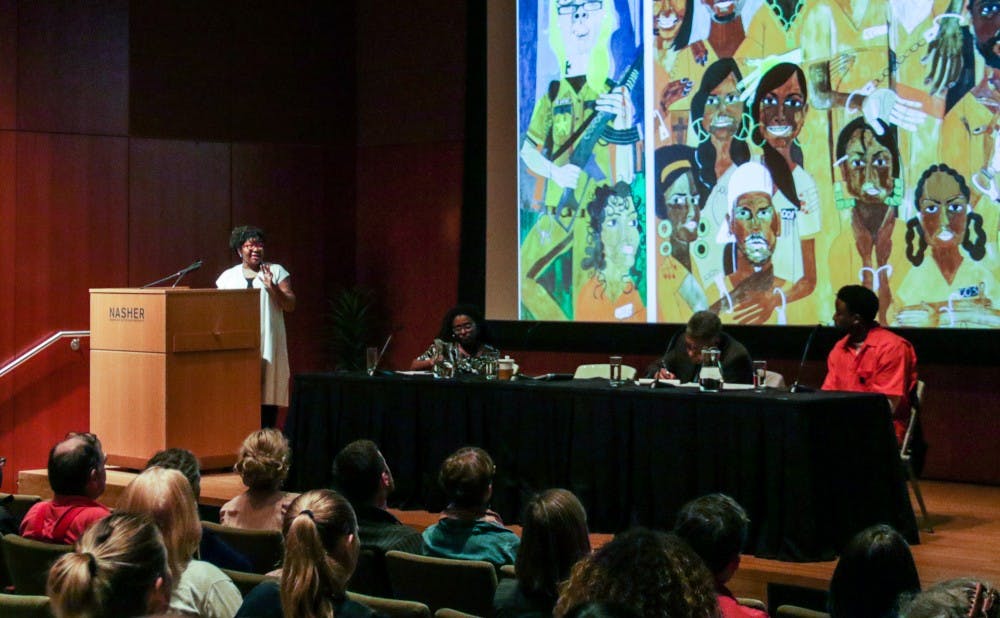Three panelists gathered Thursday night to discuss how art can reflect and inspire conversations on activism, racial justice and social policy at the Nasher Museum of Art.
The discussion, titled “Art, Activism, Race and the Law: A Conversation,” was inspired by the museum’s latest exhibition "Nina Chanel Abney: Royal Flush," which seeks to visually document and critique the complex dynamics of American society. Jillian Johnson, Trinity '03 and a member of the Durham City Council, moderated the panel, which featured professor of law Trina Jones as well as William Darity, Jr., who is the Samuel DuBois Cook professor of public policy, and artist and activist Sherrill Roland as panelists.
“While the artist doesn’t consider herself an activist, the work of Nina Chanel Abney touches upon some of the most pressing issues facing our country today,” said Marshall Price, curator of the exhibition, in his opening remarks. “At the most basic level, Nina’s paintings raise fundamental questions about human nature itself and where we find ourselves today in 2017.”
The panelists presented their own interpretations of the exhibition's connection to issues of racial justice and art activism.
Jones pointed out that Abney’s work offers a critique on the invisibility of African American women in art, mainstream feminism and the larger society.
She explained that because discussions of gender tend to focus on white women and the discussion of race tend to focus on black men, the voices of African American women are often missing.
“Race and gender are always interconnected and never exist a separately distinct, disaggregated identity,” she said. “There is no universal monolithic woman experience, just as there is no monolithic black experience, Latino experience and Asian experience.”
Jones cited and commented on one of Abney’s paintings, "Class of 2007," which features a white guard and a group of African American women prisoners.
“This juxtaposition of a white female enforcer and black female subjects eminently calls attention to the ways in which women are differently situated based on race into the fact that white women can be oppressed and oppressors due to their racial privilege.”
Jones added that the fact that 53 percent of white women voted for Donald Trump in the last presidential election is, for some black women, a confirmation of their fears that white women would prioritize race over misogyny.
“What this intersectionality critique means for activists is that we must all constantly question our starting assumptions and consider how our views are shaped by our privileges,” she said.
Roland talked about his own experience of being mistakenly incarcerated and how he created the Jumpsuit Project, intended to initiate conversations about incarceration.
In 2012, a warrant in Washington D.C. was put out for Roland's arrest, and he was charged with four felonies. He spent 10 months in prison, and a year and half after his release, he was exonerated of all charges and granted a bill of innocence. He developed the Jumpsuit Project to provide a space for people impacted by incarceration to share their stories and support each other.
Like the works of Picasso and Matisse, he explained that Abney changed the human image in her paintings.
“The figures are rarely have any facial features, but they are colored,” Darity said. “Abney is dissecting the madness of black marginalization, addressing the question of how black lives actually do not matter in the United States.”
Art can be used as a tool to create public spaces to discuss political issues, Darity noted.
“Clearly it’s very promising for the work of visual artists, filmmakers, artists in a number of domains to provide us with a prompt, to have very provocative and difficult conversations,” Darity said.
Nina Chanel Abney will be delivering a talk at the Nasher Museum on her own work next Tuesday.
Get The Chronicle straight to your inbox
Signup for our weekly newsletter. Cancel at any time.

